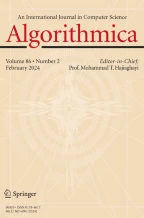Abstract.
Consider an on-line player who needs some equipment (e.g., a computer) for an initially unknown number of periods. At the start of each period it is determined whether the player will need the equipment during the current period and the player has two options: to pay a leasing fee c and rent the equipment for the period, or to buy it for a larger amount P . The total cost incurred by the player is the sum of all leasing fees and perhaps one purchase.
The above problem, called the leasing problem (in computer science folklore it is known as the ski-rental problem), has received considerable attention in the economic literature. Using the competitive ratio as a performance measure this paper is concerned with determining the optimal competitive on-line policy for the leasing problem.
For the simplest version of the leasing problem (as described above) it is known and readily derived that the optimal deterministic competitive performance is achieved by leasing for the first k-1 times and then buying, where k = P/c . This strategy pays at most 2-1/k times the optimal off-line cost.
When considering alternative financial transactions one must consider their net present value. Thus, accounting for the interest rate is an essential feature of any reasonable financial model. In this paper we determine both deterministic and randomized optimal on-line leasing strategies while accounting for the interest rate factor.
It is shown here, for the leasing problem, that the interest rate factor reduces the uncertainty involved. We find that the optimal deterministic competitive ratio is 1 + (1+i)(1-1/k)(1 - k(i/1+i)) , a decreasing function of the interest i (for all reasonable values of i ). For some applications, realistic values of interest rates result in relatively low competitive ratios. By using randomization the on-line player can further boost up the performance. In particular, against an oblivious adversary the on-line player can attain a strictly smaller competitive ratio of 2 - ( (k/(k-1)) γ - 2 )/( (k/(k-1)) γ -1 ) where γ = ln ( 1 - k(1 - 1/(1+i)) ) / ln(1/(1+i)) . Here again, this competitive ratio strictly decreases with i .
We also study the leasing problem against a distributional adversary called ``Nature.'' This adversary chooses the probability distribution of the number of leasing periods and announces this distribution before the on-line player chooses a strategy. Although at the outset this adversary appears to be weaker than the oblivious adversary, it is shown that the optimal competitive ratio against Nature equals the optimal ratio against the oblivious adversary.
Similar content being viewed by others
Author information
Authors and Affiliations
Additional information
Received October 8, 1997; revised February 8, 1998.
Rights and permissions
About this article
Cite this article
El-Yaniv, R., Kaniel, R. & Linial, N. Competitive Optimal On-Line Leasing. Algorithmica 25, 116–140 (1999). https://doi.org/10.1007/PL00009279
Issue Date:
DOI: https://doi.org/10.1007/PL00009279
